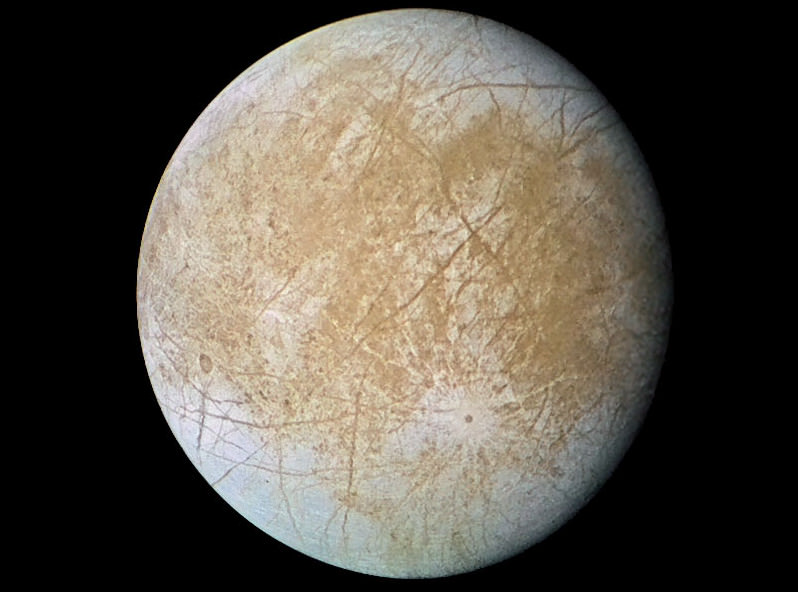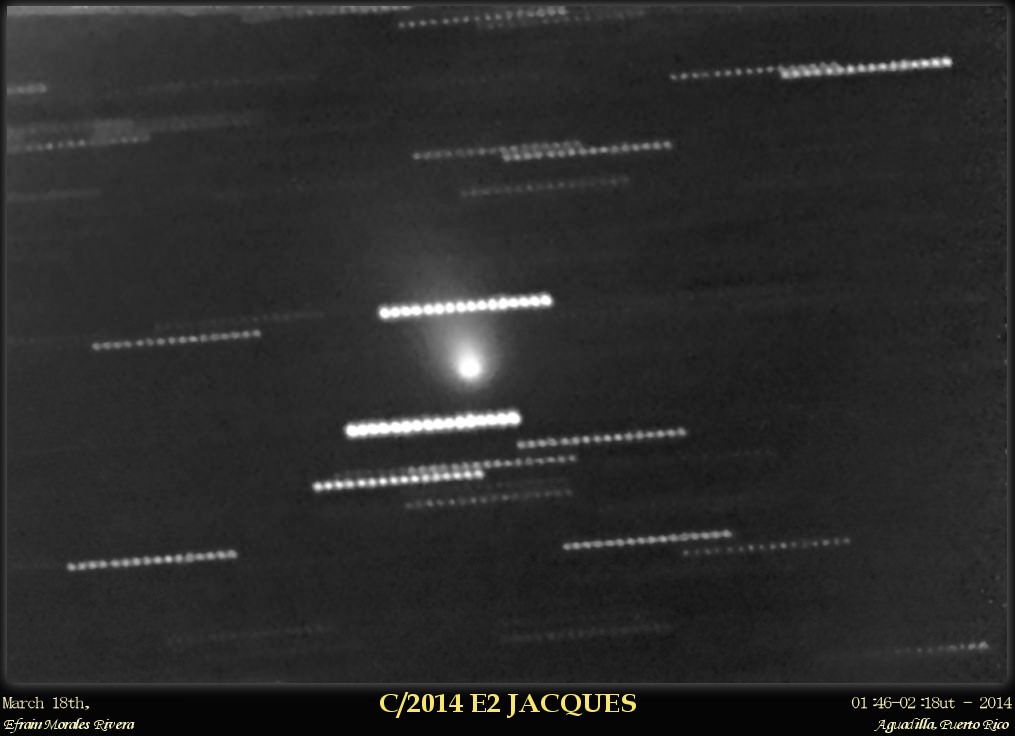We always say that the Universe is trying to kill you. But seriously… it wants you dead. The Bad Astronomer Phil Plait joins us for a very special episode of Astronomy Cast where we talk about all the different ways the Universe can take you out. You can listen to it here at Astronomy Cast!
Continue reading “Astronomy Cast Ep. 343: The Universe is Trying To Kill You!”
“Tea, Earl Grey, Hot”… How Scientists Replicated a Mars Meteorite
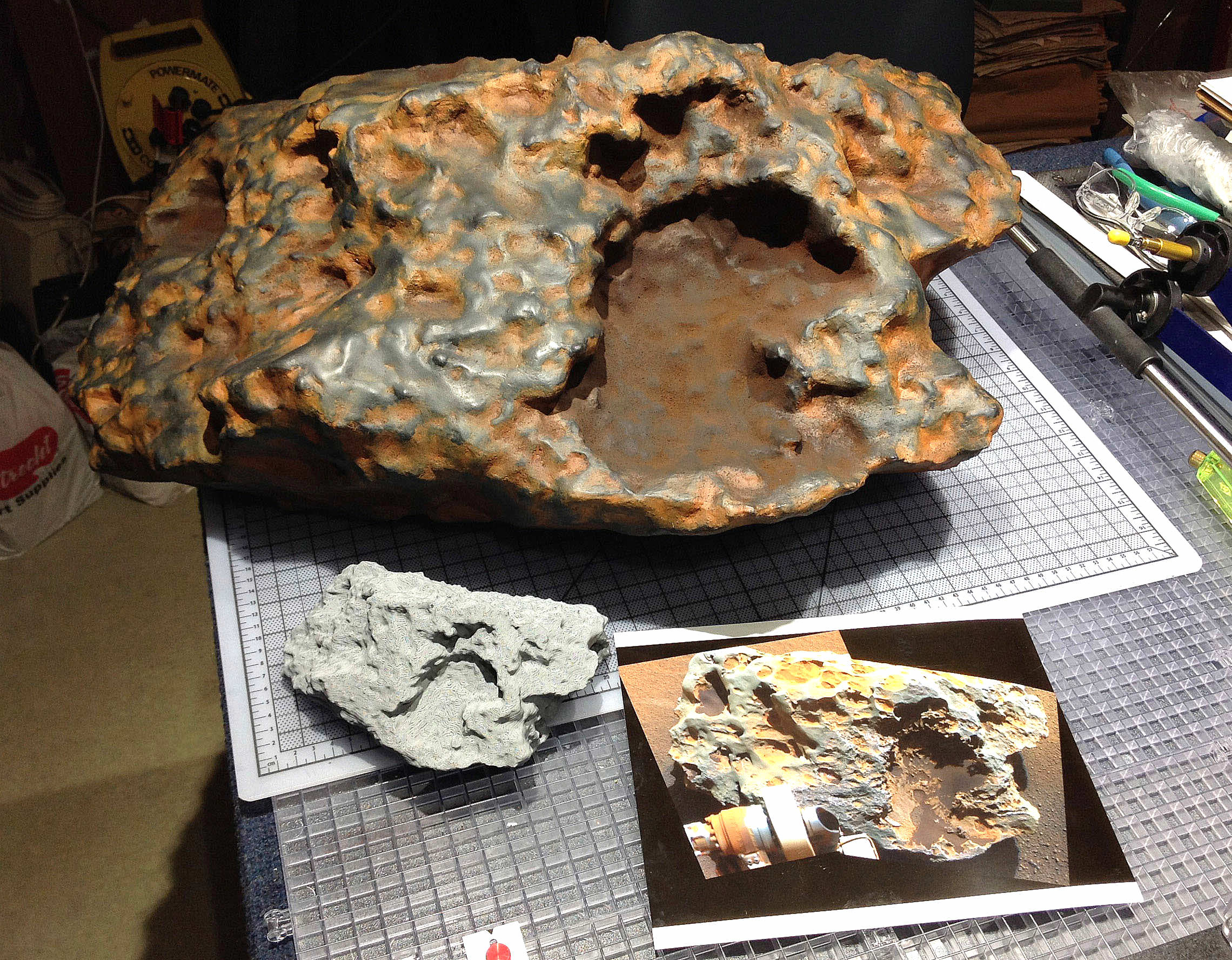
Captain Picard orders tea
“Tea, Earl Grey, hot.” Who doesn’t remember that famous command by Captain Picard’s of TV’s “Star Trek: The Next Generation”? While no one’s yet invented a replicator that can brew a cup of tea out of thin air, scientists have taken in step in that direction by creating an amazing replica of a Martian meteorite using a 3D printer.
Without the fuss and expense of a sample retrieving mission to Mars, NASA scientists now have a realistic, true to life facsimile of the ‘Block Island’ meteorite discovered by the Opportunity Rover in 2009. Block Island, an iron-nickel meteorite similar to those found at Meteor Crater in Arizona, is the largest meteorite found on the Red Planet.
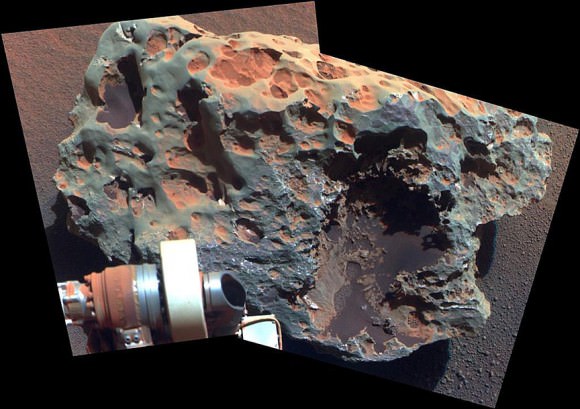
Measuring about two feet (60 cm) across, it’s about the size of picnic cooler and weighs an estimated 1,000 pounds. The replica’s made of plastic – you could tote it around like a … picnic cooler.
Analysis of Block Island’s composition using the rover’s alpha particle X-ray spectrometer confirmed that it’s rich in iron and nickel. Scientists based the design of the plastic meteorite on detailed measurements and stereo images taken by Opportunity’s panoramic camera.
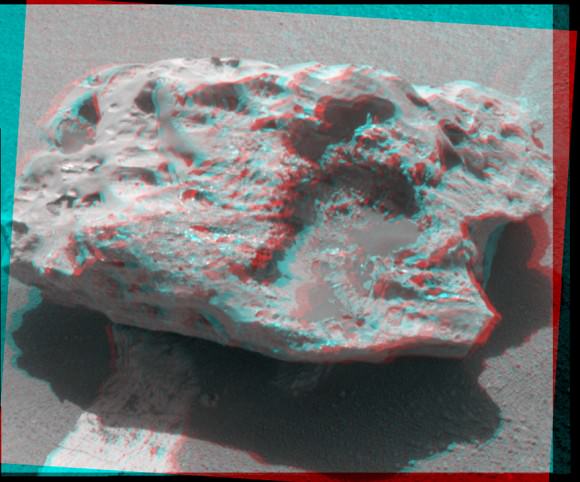
The rover made a 360-degree study of the meteorite five years ago taking measurements and many stereo images. But because Opportunity couldn’t see every square inch of the rock, the missing data created holes in the computer model, making it a poor candidate for 3D printing.
Last summer, scientists got around that problem by filling in the missing data and building small scale models of Block Island. To build the life-sized rock, they created depth meshes of the meteorite’s surface from six positions, then combined them into a three-dimensional digital model, according to researcher Kris Capraro of NASA’s Jet Propulsion Laboratory.
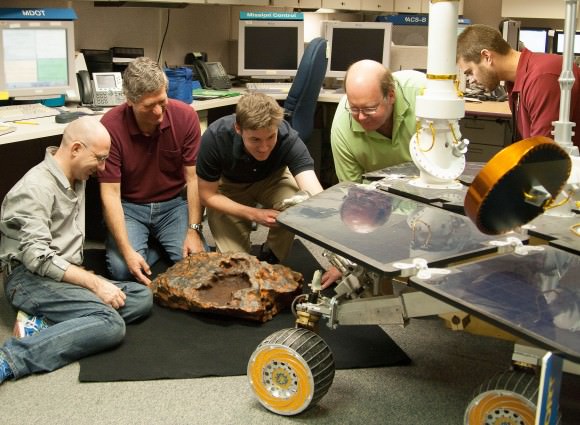
The printer built the meteorite from ABS plastic, the same material used in Lego bricks, with cord the width of the plastic line in your weed-whacker. One small problem remained before the replica could be executed – it was too big to fit in the printer’s building space. So researchers broke up the computer model of the meteorite into 11 sections. Printing took 305 hours and 36 minutes.
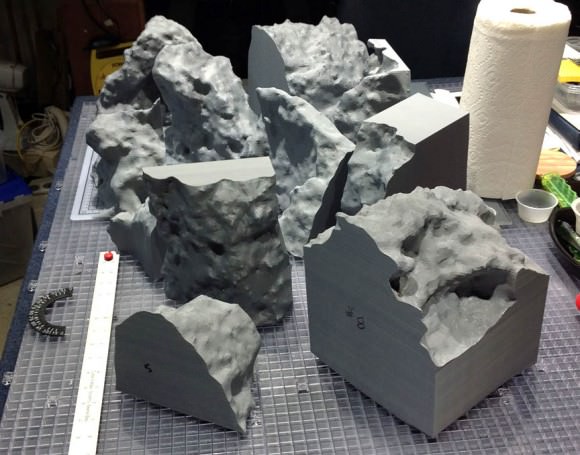
The sections were assembled and then painted to match the real rock. Said Capraro: “it’s the next best thing to bringing back real Martian rock samples back to Earth.”
Scientists hope someday to use 3D printing to not only replicate more Mars rocks but terrains across the solar system.
The Rise of Carbon Dioxide in a Single Video

I’m always amazed by the power of data visualization. In this case a video shrinks the rising levels of carbon dioxide over the course of 800,000 years to just under two minutes.
The motivation is simple: April set a carbon dioxide milestone by averaging 400 parts per million for the entire month. That’s uncharted territory over the course of human history.
The levels of carbon dioxide in the atmosphere are monitored from a site atop Hawaii’s Mauna Loa volcano, where they have been measured continuously since 1958. Previous to this date scientists measure ice cores, which contain air bubbles and therefore snapshots of carbon dioxide levels.
This animation from the Cooperative Institute for Research in Environmental Sciences makes clear that while there have been some variations over time, the current rise is unparalleled by geological scales.
Prior to the Industrial Revolution CO2 levels stayed roughly around 280 ppm. But then with the kickstart of carbon emissions, levels were driven exponentially higher. They soared past 350 ppm — the level scientist James Hansen said was the safe upper limit of CO2 — in October 1989.
The first measurement in excess of 400 ppm was made on May 9, 2013. This year, the level rose above that mark two months earlier, and has remained above 400 ppm steadily since the beginning of April. Levels will peak in May and then drop back down throughout the summer months as trees and plants soak up some CO2.
Once the northern hemisphere spins into fall, the instrument on Mauna Loa will again read higher CO2 levels. Next year will probably see an even earlier onset of levels above 400 ppm. It likely won’t be long before levels never drop lower than 400 ppm, even throughout the summer months.
Also, today the U.S. Global Change Research Program released a report that has been five years in the making, providing an overview of observed and projected climate change. It’s a lengthy document, but you can see an overview here. In sum, the report shows how the world is already experiencing the effects of climate change and the impacts are playing out before our eyes.
“We’ve seen a lot in the last five years,” said Andrew Rosenberg of the Union of Concerned Scientists, one of the lead authors on the report’s oceans chapter, in a press release from The Daily Climate. “So what we’ve tried to do is be quite comprehensive on what our observations have been, as opposed to just modeling projections.”
“Five years ago, ocean acidification and species movement was already happening, but the observational record wasn’t as clear,” Rosenberg said. “Now it really is quite clear. It’s not theory-based or model-based.”
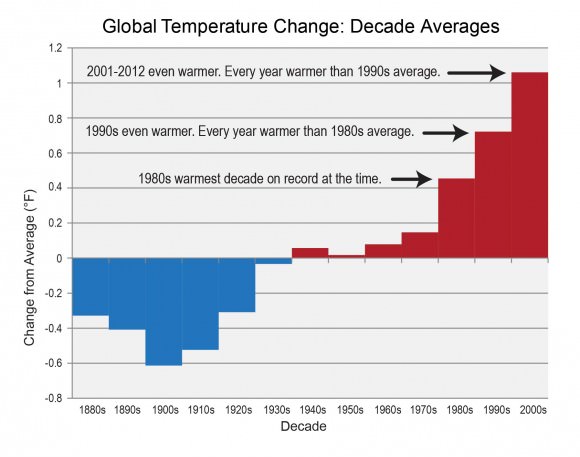
This report is unique in that it not only includes data from scientists, but also has input from local groups and industries facing climate impacts. Corn producers in Iowa, oyster growers in Washington, and maple syrup producers in Vermont are all experiencing climate-related issues. So, too, are coastal planners in Florida, water managers in the Southwest, and Native Peoples on tribal lands from Louisiana to Alaska.
Human beings are already being impacted by climate change.
Dashcams, Tweets Show Bright Daytime Fireball Over Ontario, Canada on May 4
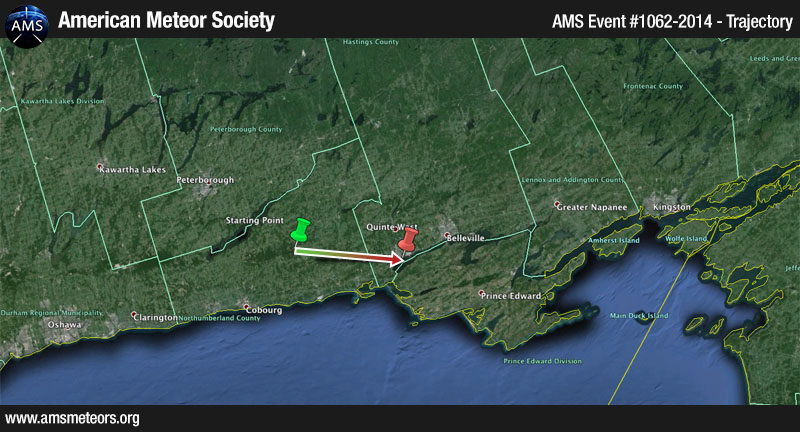
A rare daylight meteor streaked across the skies over southern Ontario, Canada and the U.S. Northeast during the afternoon of Sunday May 4, 2014, with brightness “rivaling that of the Sun,” said the American Meteor Society. Reports of a bright fireball followed by a loud sonic boom were reported on social media, and several dashcam videos emerged showing the fireball, showing an unusual vertical trajectory.
Experts estimated the space rock that caused the excitement as being about half to one meter in diameter and exploding with a force of 50 tons of TNT energy. Canadian meteor expert Peter Brown, a professor at the University of Western Ontario said in the Winnipeg Free Press that he is confident that the fireball was large enough that some meteorite fragments may have hit the ground. .
Compared to the meteor that exploded over Chelyabinsk, Russia in February of 2013, that’s quite small. That meteor’s explosion shattered windows and injured 1,000 people.
See more videos, tweets and images below, and you can read a liveblog of the event (with lots of links) by Daniel Fischer (@cosmos4u).
Taken in Port Hope, ON at 4:20 pm. Looked like meteor exploding. Heard BOOM. Then rumble. Ground shook #meteor pic.twitter.com/RQfZ7r55Do
— DC-Photography (@DCPhotographyON) May 5, 2014
Here's the photo of the #meteor contrail over GTA and Durham! Saw this from Whitby…. Seeing this made my day pic.twitter.com/gINzrFeMc9
— Veronica (@iVeronica) May 4, 2014
Sonic boom you felt. RT @island_gurl75: #meteor strikes or explodes near #Peterborough. We felt 4 big bangs, felt like a car hit the house!
— Dënnis (@DennisOBrienJr) May 4, 2014
Read more news reports at the American Meteor Society, Globe and Mail, and Global News.
Unprecedented Images of the Intergalactic Medium
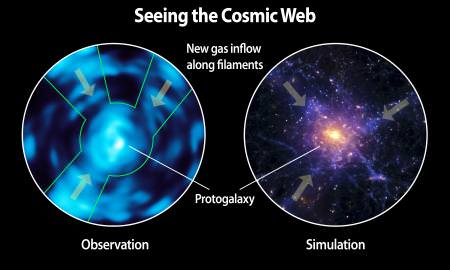
An international team of astronomers has taken unprecedented images of intergalactic space — the diffuse and often invisible gas that connects and feeds galaxies throughout the Universe.
Until now, the structure of intergalactic space has mostly been a matter for theoretical speculation. Advanced computer simulations predict that primordial gas from the Big Bang is distributed in a vast cosmic web — a network of filaments that span galaxies and flow between them.
This vast network is impossible to see alone. In the past astronomers have looked at distant quasars — supermassive black holes at the centers of galaxies which are rapidly accreting material and shining brightly — to indicate the otherwise invisible matter along their lines of sight.
While distant quasars may reveal the otherwise invisible gas, there’s no information about how that gas is distributed across space. New images, however, from the Cosmic Web Imager are revealing the webs’ filaments directly, allowing them to be seen across space.
The first filaments observed by the Cosmic Web Imager are in the vicinity of two ancient but bright objects: the quasar QSO 1549+19 and a so-called Lyman alpha blob (yes, this is a technical term for a huge concentration of hydrogen gas) in the emerging galaxy cluster SSA22. These objects are bright, lighting up the intervening galactic space and boosting the detectable signal.
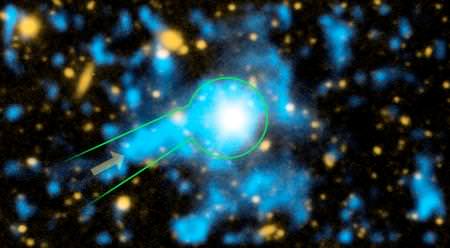
Image Credit: Christopher Martin, Robert Hurt
Both objects date back to two billion years after the Big Bang, in a time of rapid star formation in galaxies. Observations show a narrow filament, about one million light-years across flowing into the quasar, which is likely fueling the growth of the host galaxy.
There are three filaments flowing into the Lyman alpha blob. “I think we’re looking at a giant protogalactic disk,” said lead author Christopher Martin from the California Institute of Technology in a press release. “It’s almost 300,000 light-years in diameter, three times the size of the Milky Way.”
The Cosmic Web Imager on board the Hale 200 inch telescope is a spectrographic imager, taking pictures at many different wavelengths simultaneously. This allows astronomers to learn about objects’ composition, mass and velocity.
“The gaseous filaments and structures we see around the quasar and the Lyman alpha blob are unusually bright,” said Martin. “Our goal is to eventually be able to see the average intergalactic medium everywhere. It’s harder, but we’ll get there.”
Both papers (“Intergalactic Medium Observations with the Cosmic Web Imager: I. The Circum-QSO Medium of QSO 1549+19 and Evidence for a Filamentary Gas Inflow” and “Intergalactic Medium Observations with the Cosmic Web Imager: II. Discovery of Extended, Kinematically-linked Emission around SSA22 Ly-alpha Blob 2”) have been published in the Astrophysical Journal.
NASA Seeks Ideas for Mission to Europa
Europa — a moon of Jupiter first discovered by Galileo — never ceases to surprise and amaze astronomers and amateurs alike.
Last December astronomers announced water plumes erupting 100 miles high from the moon’s icy south pole. It was the best evidence yet that Europa, heated internally by the powerful tidal forces generated by Jupiter’s gravity, has a deep subsurface ocean. It caused the search for life in the outer solar system to take quite a turn.
Now, NASA has issued a Request for Information (RFI) to science and engineering communities for ideas for a mission to the enigmatic moon. Any ideas need to address fundamental questions about the subsurface ocean and the search for life beyond Earth.
“This is an opportunity to hear from those creative teams that have ideas on how we can achieve the most science at minimum cost,” said John Grunsfeld, associate administrator for the NASA Science Mission Directorate, in a press release.
The RFI’s focus is for concepts for a mission that costs less than $1 billion.
“Europa is one of the most interesting sites in our solar system in the search for life beyond Earth,” said Grunsfield. “The drive to explore Europa has stimulated not only scientific interest but also the ingenuity of engineers and scientists with innovative concepts.”
The Decadal Survey deemed a mission to Europa as an extremely high priority for scientific pursuits by NASA. It lists five key science objectives that are necessary to improve our understanding of this potentially habitable moon. Primarily, the mission will need to:
— Characterize the extent of the ocean and its relation to the deeper interior
— Characterize the ice shell and any subsurface water, including their heterogeneity, and the nature of surface-ice-ocean exchange
— Determine global surface, compositions and chemistry, especially as related to habitability
— Understand the formation of surface features, including sites of recent or current activity, identify and characterize candidate sites for future detailed exploration
— Understand Europa’s space environment and interaction with the magnetosphere.
Although Europa has been visited by spacecraft and imaged distantly by Hubble, more detailed research is necessary to understand the complexities of this moon and its potential for life. NASA’s Galileo spacecraft, launched in 1989 was the only mission to visit Europa, passing close by the moon fewer than a dozen times.
What are your ideas for a mission to the icy moon? Comment below.
Comet Jacques Brightens: How to See it in May
A recently discovered comet is headed northward and is set to put on one of two fine performances for binocular observers in 2014 starting this week.
Comet C/2014 E2 Jacques was discovered on March 13th 2014 by Cristóvão Jacques, Eduardo Pimentel and João Ribeiro de Barros while observing from the Southern Observatory for Near Earth Asteroids Research (SONEAR) facility located near Oliveira, Brazil.
The comet was just about at +15th magnitude at the time of discovery as it glided across the southern hemisphere constellation of Centaurus.
While a majority of comet discoveries are destined to remain small and faint, Comet Jacques was immediately shown to be something special. Upon discovery of any new comet, the first task is to gain several observations hours or nights apart to accurately gauge its distance and orbit. Are astronomers looking at a small, garden variety comet close up, or a large, active one far away?
In the case of Comet Jacques, it was something in between: a comet about 1.22 Astronomical Units (A.U.s) distant at time of discovery. Comet Jacques is headed towards perihelion 0.66 A.U. from the Sun in early July and will pass 0.56 A.U. from Earth on August 28th. Follow up observations carried out using the iTelescope at Siding Spring Australia showed a slightly elongated coma about 2 arc minutes across shortly after discovery, and the comet has recently jumped up to magnitude +8 — ahead of the projected light curve — in just the past week.
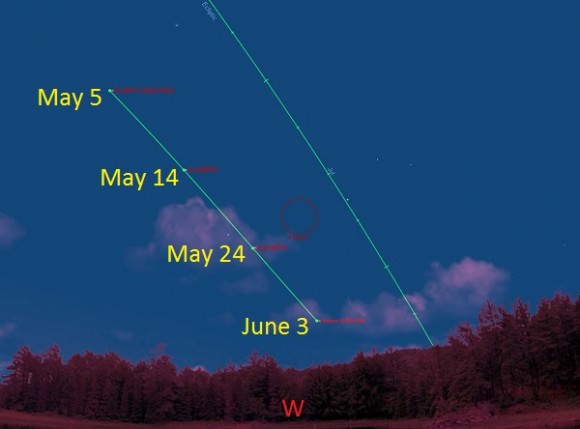
We caught our first good look at Comet Jacques last night while setting up for the Virtual Star Party. While +10 magnitude or brighter is usually a pretty good rule of thumb for binocular visibility, we found that the comet was only apparent as a fuzzy smudge viewing it with a 8” Schmidt-Cassegrain telescope using averted vision at low power. Remember, the brightness of a comet is spread out over its apparent surface area, similar to viewing a diffuse nebula. Our first telescopic views of the ill-fated comet ISON as it breeched +10th magnitude were similar. Certainly, a nearby waxing crescent Moon in Gemini last night didn’t help.
How bright will Comet Jacques get? Current projections call for it to perhaps break naked eye visibility around +6th magnitude after June 1st and reach as bright as +4th magnitude in early July near perihelion. After its first evening act in May and June, Comet Jacques will reemerge in the dawn sky for northern hemisphere observers for Act 2 and trace a path northward paralleling the galactic plane through the star rich fields of Perseus, Cassiopeia, Cepheus and Cygnus in August and September of this year. If our luck holds out, Comet Jacques will remain above 6th magnitude until early September.
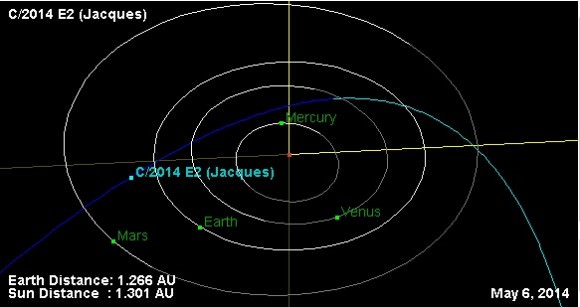
This comet also created a brief flurry of interest when it was revealed that it will pass just 0.085 AUs or 12,700,000 kilometers from Venus on July 13th, 2014. Though close, this is still 31 times the distance from Earth to the Moon. The only “eyes” that humanity has currently in operation around Venus is ESA’s Venus Express orbiter. During closest approach Comet Jacques will appear just over 3 degrees away from Venus as seen from our Earthly vantage point.
Another comet is also set to photobomb a planet, as Comet A1 Siding Spring passes a nominal distance of 0.0009 A.U.s or 135,000 kilometers from Mars this Fall on October 19th.
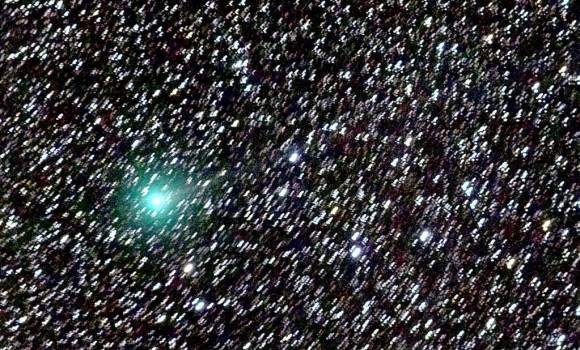
The closest recorded passage of a comet near Earth was Comet D/1770 L1 Lexell in 1770, which passed us 0.015 A.U.s or 233 million kilometres distant.
Now on to Act 1. May finds Comet Jacques spending most of the month in the long rambling constellation of Monoceros. Currently moving just under 2 degrees a day, Comet Jacques crosses the celestial equator northward this week on May 8th. You’ll note its high orbital inclination of 156.4 degrees as it speeds northward. Comet Jacques has a long orbital period gauged at over 30,000 years — the last time Comet Jacques visited the inner solar system, our ancestors had the Last Glacial Maximum period to look forward to.

Comet Jacques is currently the brightest comet “with a bullet,” edging out the +9th magnitude comets C/2012 K1 PanSTARRS gilding through Canes Venatici and comet C/2012 X1 LINEAR, currently residing in the constellation of Aquila the Eagle. A great place to keep up with current observations of comets is the Comet Observation Database. We’re also pinging the IAU Minor Planet Center’s quick look page for new discoveries daily.
Here are some highlights to watch out for as Comet Jacques heads towards perihelion. Passages within one degree — twice the size of the Full Moon — near stars brighter than +5th magnitude are noted unless mentioned otherwise:
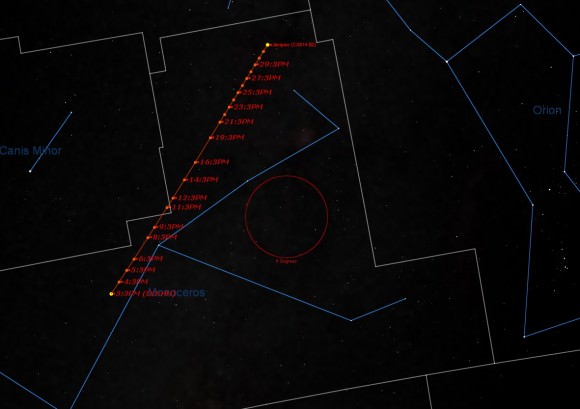
May 8th: Passes the +4.1 magnitude star Delta Monocerotis and crosses north of the celestial equator.
May 10th: Passes planetary nebula NGC 2346.
May 11th: Passes briefly into Canis Minor before reentering the constellation Monoceros.
May 14th: Full Moon occurs, marking the start of a favorable two week period of moonless evenings soon after.
May 24th: Passes the +4.8 magnitude star 17 Monocerotis.
May 28th: New Moon occurs, marking the return of the Moon to early evening skies.
May 29th: Passes the +4.7 magnitude star 15 Monocerotis.
May 30th: Passes the Christmas tree cluster. Photo op!
May 31st: The waxing crescent Moon passes less than 8 degrees from Comet Jacques.
June 1st: Comet Jacques reaches naked eye visibility?
June 6th: Crosses into the constellation Gemini.
June 11th: Crosses into the constellation Taurus.
June 13th: Full Moon occurs.
June 14th: Crosses the galactic plane.
June 21st: Passes into the field of view of SOHO’s LASCO C3 camera.
June 27th: New Moon occurs.
July 2nd: Reaches perihelion at 0.6638 A.U. from the Sun.
July 8th: Crosses north of the ecliptic plane.
July 13th: Passes 0.085 A.U. from Venus.
August 28th: Passes 0.56 A.U. from Earth.
And thus, Comet Jacques joins the parade of fine binocular comets in the 2014 night sky, as the stage is set for Act 2 this fall. And keep in mind, the next “big one” could grace our skies at anytime… more to come!
Carnival of Space #352
The tent is up! This week’s Carnival of Space is hosted by Pamela Hoffman at the Everyday Spacer blog.
Click here to read Carnival of Space #352.
And if you’re interested in looking back, here’s an archive to all the past Carnivals of Space. If you’ve got a space-related blog, you should really join the carnival. Just email an entry to [email protected], and the next host will link to it. It will help get awareness out there about your writing, help you meet others in the space community – and community is what blogging is all about. And if you really want to help out, sign up to be a host. Send an email to the above address.
Earth From Space: The Moon Over Mexico
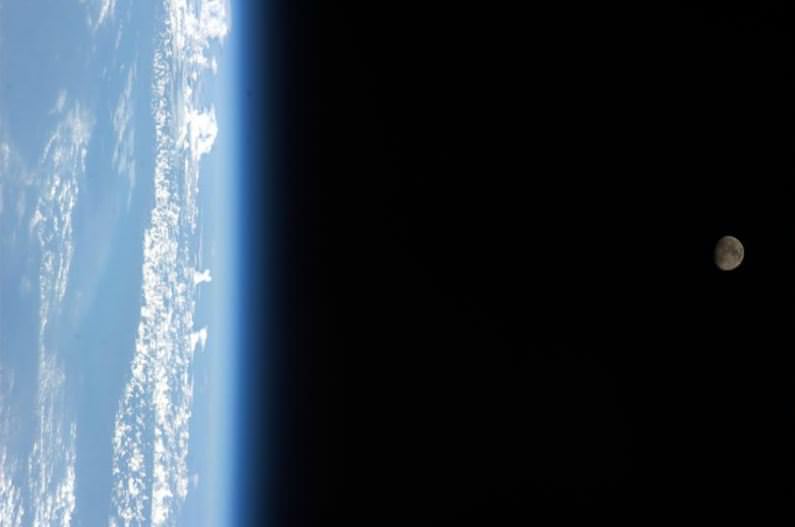
Happy Cinco de Mayo! This beautiful image of Earth from Space was taken earlier this year, but today is a perfect day to share it. ISS astronaut Rick Mastracchio snapped this photo of the waxing gibbous Moon on March 12, 2014.
The 5th of May commemorates a victory for Mexico in the Battle of Puebla in 1862 during the Franco-Mexican War. It wasn’t an especially crucial battle, but it became a symbol of Mexican pride and a celebration of Mexican culture in the United States. Cinco de Mayo isn’t widely celebrated in Mexico, but it is celebrated by many Americans regardless of their heritage (like St. Patrick’s Day and Oktoberfest).
This photo reminds us of the fragility and beauty of our world that we all inhabit together.
Via Fragile Oasis
Virtual Star Party – May 4, 2014: It’s Galaxy Season!
Hosts: Fraser Cain and Scott Lewis
Astronomers: Gary Gonella, Andrew Dumbleton, Stuart Foreman, David Dickinson, Shahrin Ahmad and special guest Henna Khan from Bombay, India
Tonight’s Views:
the Moon’s surface
M44 Beehive Cluster
Neutron Star B224 from HST
All-Sky View
Mars with ice caps and Hellas Basin visible
Comet C/2012 K1 PanSTARRS
Stuart demonstrating how to work with software to process images
M51a Whirlpool Galaxy
M53 Globular Cluster
Rosette Nebula – NGC 2237, 2238, 2239 and 2246
Saturn
Horsehead Nebula (Barnard 33 in emission nebula IC 434) and Flame Nebula (NGC 2024) with a satellite trail
NGC 5139 Omega Centauri
M42 Orion Nebula
M63 Sunflower Galaxy
NGC 7635 Bubble Nebula
Large and Small Magellanic Clouds
We hold the Virtual Star Party every Sunday night as a live Google+ Hangout on Air. We begin the show when it gets dark on the West Coast. If you want to get a notification, make sure you circle the Virtual Star Party on Google+. You can watch on our YouTube channel or here on Universe Today.

